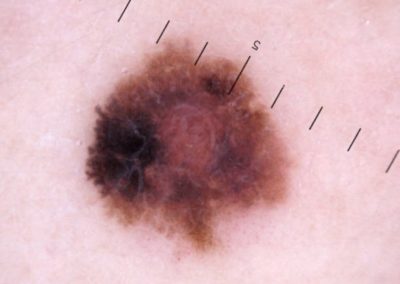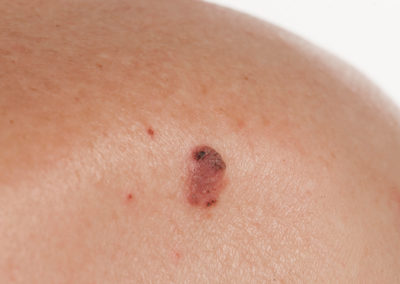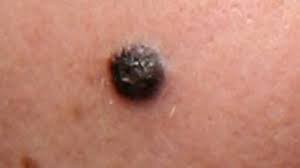Melanoma
Melanoma is the third most common cancer in both Australian men and women.
Whilst melanoma is the deadliest form of skin cancer, 90% of melanomas detected and treated early can be cured.
What is melanoma?
It is the least common type but carries the highest risk of becoming aggressive and causing death.
Best outcomes are achieved with early detection and treatment.
Melanoma occurs when there is uncontrolled abnormal growth of melanocytes (pigment cells) within the skin.
What are the risk factors for melanoma?
Risk factors for melanoma include:
- Recurrent sunburns especially in childhood or adolescence (even one serious sunburn can cause dangerous cell mutations)
- Pale skin and fair hair, many moles and freckles on the body, although darker skin people are not immune the risk is lower
- Any use of tanning beds
- A family history of melanoma and dysplastic naevus syndrome (an inherited condition which causes hundreds of abnormal moles over the body).
- A personal history of a previous skin cancer
- High risk outdoor occupations such as farmers and roofers, builders and swim teachers.
What are the symptoms of melanoma?
- Melanomas often have no symptoms and as such can be “silent killers”.
- The first noticeable sign is generally a change in an existing mole, or the appearance of a new mole.
- Suspicious moles are moles that itch,have different colour shades within the same mole, become blotchy, get bigger, increase in height or develop a raised area are also red flags.
- Also watch for weepy, bleeding or scaly spots that don’t heal
- Also be wary of new moles that suddenly appear or that you have never noticed before
- Rarer forms of melanoma can appear as dark areas or bands around or under the nails, or brown pigmentation on the genitals.
- Melanomas can also occur on the scalp often unnoticed under hair or behind the neck.
- Melanoma of the foot is notoriously difficult to treat because frequently it is advanced before people notice. A relatively uncommon type of skin cancer (unrelated to sun exposure) is acral lentiginous melanoma (ALM) of the foot. Foot melanomas cause only 1 per cent of skin cancers, yet cause more cancer deaths than any other skin cancer.
When should I do self checks and when should I get a doctor skin check?
- It’s important to do regular self self-checks for skin cancer every two or three months, and photograph and measure any moles you are concerned about.
- Don’t forget to check the soles of the feet, under the nails and ask someone to blow your scalp with the dryer on cool to check your scalp.
- In addition if you are high risk you should see your skin clinic, dermatologist or GP for a full-body skin exam at least once a year, or your doctor may suggest more frequent checks depending on your risk profile.
What are the ABCDE signs of melanoma skin cancer?
The first sign of a melanoma is usually the appearance of a new mole or change in the size, shape, colour or texture of an existing mole.
The ABCDE of melanoma detection is a useful guide for self-skin checks:
A – Asymmetry (one half does not match the other)
B – Border irregularity (edges irregular)
C – Colour variation (number of colours such as black, blue, red or white)
D – Diameter (larger than 6mm think the rubber size on HB pencil)
E – Evolving (changing or growing)
Top tip: Beware of the “evolving” mole as this is the strongest of all the warning signs.
What is the best way to prevent melanoma and other skin cancers?
Remember that skin cancer has a unique causation.
Unlike bowel or breast cancer that can be due to many different things we can control like weight, smoking or alcohol, skin cancer has a very clear sun causation.
More than 99% of all non-melanoma skin cancers and 95% of melanomas are directly related to UV exposure
So remember to:
- Apply sunscreen before leaving the house, make sure it’s accessible as your toothpaste
- Have one tube for the bathroom, the bedroom and keep one in your car or in your bag.
- Use one teaspoon of sunscreen per limb and don’t forget behind the ears, tops of head including the part line, eyelids, tops of the feet and behind the knees
- Download the free SunSmart App to know when you need protection and to get reminders to reapply your sunscreen
- Avoid direct sun exposure in the middle of the day 10am to 2pm
- Take breaks in shade where possible and remember working on grass where possible is better than reflective surfaces such as concrete, sand or water.
- When the UV index is over 3 use all five forms of sun protection in this checklist
What is the treatment for melanoma and other skin cancers?
A biopsy is often recommended as the first investigation to find out what type of skin cancer a suspicious lesion may be.
This information often helps direct treatment.
Most skin cancers will be excised (removed by surgery) with a ‘safety margin’ of normal surrounding skin.
Other treatments may be recommended instead or in combination with surgery. These include:
- Topical treatments – chemotherapeutic agents applied to the skin, usually for more superficial less advanced cancers.
- Photodynamic therapy – chemotherapy cream activated by light.
- Graft or flap repair – if the wound left behind from a skin cancer surgery is quite large or tight, skin may need to be used from a nearby region to help close the wound.
- Mohs surgery – a form of staged skin cancer excision
- Sentinel lymph node Biopsy,SLNB, Lymph node biopsy or removal – if required, dye is injected into the skin in the area of a skin cancer and suspicious lymph nodes are removed and examined for cancer spread.
- Radiotherapy – x-ray treatment can be used as a sole treatment, or as an adjunct (together with surgery), or following systemic therapy.
- Systemic therapy – this includes chemotherapy, targeted therapy and immunotherapy. These systemic treatments are used for aggressive skin cancers or those that have spread from the skin to other parts of the body.
See our melanoma and skin cancer treatments page here.





